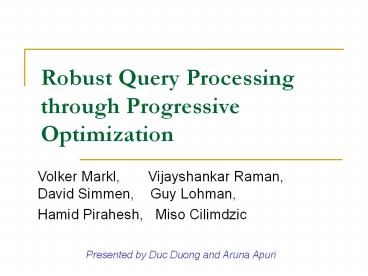Robust%20Query%20Processing%20through%20Progressive%20Optimization PowerPoint PPT Presentation
Title: Robust%20Query%20Processing%20through%20Progressive%20Optimization
1
Robust Query Processing through Progressive
Optimization
Volker Markl, Vijayshankar Raman, David
Simmen, Guy Lohman, Hamid Pirahesh, Miso
Cilimdzic Presented by Duc Duong and Aruna Apuri
2
Motivation
- Current optimizers depend heavily upon the
cardinality estimations - What if there errors in those estimations?
- Errors can occur due to
- Inaccurate statistics
- Invalid assumptions (e.g. attribute independence)
3
Overview of Talk
- Contribution of the paper
- Progressive Query Optimization(POP)
- CHECK and its variants
- Performance analysis
- A real-world experiment results
4
Contribution
- Concept of CHECK and its various flavors
- Method for determining validity ranges for QEPs
- Performance analysis of prototype of POP
5
Evaluating a Re-optimization Scheme
- Risk Vs Opportunity
- Risk
- Extent to which re-optimization is not worthwhile
leads to performance regression. - Regression may occur when Re-optimization of
query results in selection of same or even worse
plan. - Regression may occur when Query execution needs
to be repeated
6
Evaluating a re-optimization scheme
- Risk Vs Opportunity
- Opportunity
- Refers to the aggressiveness
- Higher the number of CHECK operators
- higher the opportunity for re-optimization
- Opportunity directly correlated to risk
7
Progressive Query Optimization(POP)
8
Architecture of POP 1
- Find out valid ranges
- Location of CHECKs
- Executing CHECKs
- Interpret CHECK
- Exploit intermediate results
9
Architecture of POP 2
10
Computation on Validity Ranges
- Validity range is an upper and lower bound which
when violated, guarantees that the current plan
is sub-optimal wrt to the optimizers cost model - No need to enumerate all possible optimal plans
beforehand - Uses modified Newton-Raphson method to find
validity ranges
11
Exploiting Intermediate Results
- All the intermediate results are stored as
temporary MVs - Not necessarily written out to disk
- In the end, all these temporary MVs needs to be
deleted (extra overhead?)
12
Variants of CHECK
- Lazy checking
- Lazy checking with eager materialization
- Eager checking without compensation
- Eager checking with buffering
- Eager checking with deferred compensation
13
Lazy Checking
- Adding CHECKs above a materialization point
(SORT, TEMP etc) - As, no results have been output yet
- And materialized results can be re-used
14
Lazy checking with eager materialization
- Insert materialization point if it does not
exists already - Typically done only for nested-loop join
15
Eager Checking
- EC without Compensation
- CHECK is pushed down the MP
- EC with buffering
- CHECK and buffer
16
EC with Deferred Compensation
- Only SPJ queries
- Identifier of all rows returned to the user are
stored in a table S, which is used later in the
new plan for anti-join with the new-result stream
17
CHECK Placement
18
Performance Analysis
- Robustness
19
Risk Analysis
- Risk Analysis
20
Opportunity Analysis
21
POP in Action
- 22 Vs 17
22
Conclusions
- POP gives us a robust mechanism for
re-optimization through inserting of CHECK (in
its various flavors) - Higher opportunity at low risk
23
Reference
- Volker Markl, Vijayshankar Raman, David Simmen,
Guy Lohman, Hamid Pirahesh, Miso Cilimdzic,
Robust Query Processing through Progressive
Optimization, SIGMOD 2004, June 1318, 2004,
Paris, France. - www.cse.iitb.ac.in/dbms/Data/Courses/CS632/Talks/P
OP.ppt

